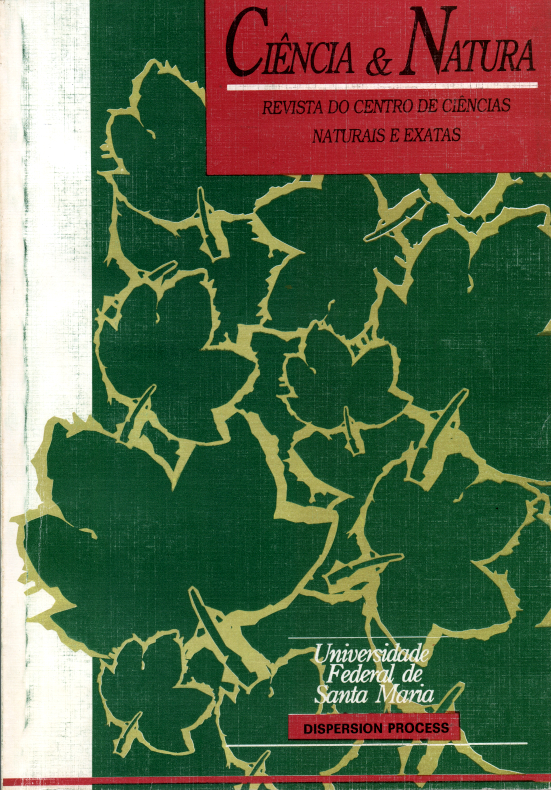Modelagem da circulação atmosférica na região da usina termoelétrica de Candiota
DOI:
https://doi.org/10.5902/2179460X36903Abstract
In this paper it is used the Regional Atmospheric Modeling System (RAMS) in order to simulate the atmospheric circulation around the Candiota Thermoelectric Power Plant. Two numerical experiments are showed. The first one describes the sensitivity of the model to the local topography. In the second one the model is initialized with data from CPTEC/INPE and the results are compared with data obtained in fields campaigns. This comparison indicates that the RAMS outputs are an useful tools to be used in atmospheric dispersion models to describe the pollutant transport emitted by the Candiota source.Downloads
References
Avissar R. and F. Chen (1993). Development and Analysis of Prognostic Equations for Mesoescale Kinetic Energy and Mesoescale (Subgrid Scale) Fluxes for Large-Scale Atmospheric Models, Journal of the Atmospheric Sciences, 50, 3751- 3774. DOI: https://doi.org/10.1175/1520-0469(1993)050<3751:DAAOPE>2.0.CO;2
Clark, T. L., (1977) A small-scale dynamic model using a terrain-following coordinate transformation. J. Comp. Phys., 24, pp. 186-215. DOI: https://doi.org/10.1016/0021-9991(77)90057-2
Chen, C., and W. R. Cotton (1983) A One-Dimensional Simulation of the Stratocumulus-Capped Mixed Layer. Boundaty Layer Meteorology, 25, pp. 289-321. DOI: https://doi.org/10.1007/BF00119541
Cotton, W. R., Tripoli, G. J. (1978). Cumulus convection in Shear Flow - Three-Dimensional Numerical Experiments. J. Atmos. Sci., 35, 1503-1521. DOI: https://doi.org/10.1175/1520-0469(1978)035<1503:CCISFD>2.0.CO;2
McCumber, M. C., and R. A. Pielke (1981). Simulation of the Effects of the Surfece Fluxes of Heat and Moisture in a Mesoescale Numerical Model. Part I: Soil Layer. J. Geophys+. Res., 86, pp. 9929-9938. DOI: https://doi.org/10.1029/JC086iC10p09929
Moraes, O L. L., Oliveira, A P., Neto, E. C. e Degrazia, G.A., Air Pollution: The Candiota Field Program, 125pp (1996)
Moraes, O. L. L. (2000), Turbulence Characteristics in the Surface Boundary Layer over the South America Pampa, aceito para publicação na Boundary Layer Meteorology. DOI: https://doi.org/10.1023/A:1002604624749
Pielke, R. A., Cotton, W. R., Walko L. R., Tremback C. J., Lyons W. A., Grasso L. D., Nicholls M. E., Moran M. D., Wesley D. A., Lee T. J., Copeland J. H., (1992). A Comprehensive Meteorological Modeling System - RAMS. Meteorological Atmos. Phys. 69-90. DOI: https://doi.org/10.1007/BF01025401
Silva Dias, P., comunicação pessoal (1999).
Smagorinsky, J. (1963). General Circulation Experiments with the Primitive Equations. 1: The Basic Experiment. Mon. Weather Rev., 91, pp. 99-164 DOI: https://doi.org/10.1175/1520-0493(1963)091<0099:GCEWTP>2.3.CO;2
Stull, R.B., 1988: An Introduction to Boundary Layer Meteorology, Kluwer Academic Publishers, Dordrecht, Holanda. DOI: https://doi.org/10.1007/978-94-009-3027-8
Tremback, C. J., J. Powell, W. R. Cotton and R. Pielke (1987). The Forward-in-Time Upstream Scheme: Extension to Higher Orders. Mon. Wea. Rev., 115, pp. 540-555 DOI: https://doi.org/10.1175/1520-0493(1987)115<0540:TFTUAS>2.0.CO;2
Tremback, C. J., and R. Kessler (1985). A Surfece Temperature and Moisture Parametrization for use in Mesoescale Nemerical Models. Preprints, 7 th. Conference on Numerical Weather Prediction, Montral, Canada, MAS, 17-20 June 1985.
Tremback, C. J., (1990). Numerical Simulation of a Mesoescale Convective Complex: Model Development and Numerical Results. Department of Atmospheric Science. Colorado State University.
Tripoli, G. J. and W. R. Cotton (1980). A Numerical Investigation of Several Factors Leading to the Observed Variable Intensity of Deep Convection over South Florida. J. Appl. Meteor., 19, 1037-1063. DOI: https://doi.org/10.1175/1520-0450(1980)019<1037:ANIOSF>2.0.CO;2
Tripoli, G. J. and W. R. Cotton (1982). The Colorado State University Tree-Dimensional Cloud / Mesoescale Model. Parte I: General Theorical Framework and Sensitivity Experiments. J. Recherches Atmos., 16, pp. 186-219.
Downloads
Published
How to Cite
Issue
Section
License
To access the DECLARATION AND TRANSFER OF COPYRIGHT AUTHOR’S DECLARATION AND COPYRIGHT LICENSE click here.
Ethical Guidelines for Journal Publication
The Ciência e Natura journal is committed to ensuring ethics in publication and quality of articles.
Conformance to standards of ethical behavior is therefore expected of all parties involved: Authors, Editors, Reviewers, and the Publisher.
In particular,
Authors: Authors should present an objective discussion of the significance of research work as well as sufficient detail and references to permit others to replicate the experiments. Fraudulent or knowingly inaccurate statements constitute unethical behavior and are unacceptable. Review Articles should also be objective, comprehensive, and accurate accounts of the state of the art. The Authors should ensure that their work is entirely original works, and if the work and/or words of others have been used, this has been appropriately acknowledged. Plagiarism in all its forms constitutes unethical publishing behavior and is unacceptable. Submitting the same manuscript to more than one journal concurrently constitutes unethical publishing behavior and is unacceptable. Authors should not submit articles describing essentially the same research to more than one journal. The corresponding Author should ensure that there is a full consensus of all Co-authors in approving the final version of the paper and its submission for publication.
Editors: Editors should evaluate manuscripts exclusively on the basis of their academic merit. An Editor must not use unpublished information in the editor's own research without the express written consent of the Author. Editors should take reasonable responsive measures when ethical complaints have been presented concerning a submitted manuscript or published paper.
Reviewers: Any manuscripts received for review must be treated as confidential documents. Privileged information or ideas obtained through peer review must be kept confidential and not used for personal advantage. Reviewers should be conducted objectively, and observations should be formulated clearly with supporting arguments, so that Authors can use them for improving the paper. Any selected Reviewer who feels unqualified to review the research reported in a manuscript or knows that its prompt review will be impossible should notify the Editor and excuse himself from the review process. Reviewers should not consider manuscripts in which they have conflicts of interest resulting from competitive, collaborative, or other relationships or connections with any of the authors, companies, or institutions connected to the papers.






